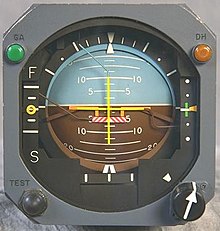Attitude indicator
This article includes a list of general references, but it lacks sufficient corresponding inline citations. (December 2010) |

An attitude indicator (AI), also known as gyro horizon or artificial horizon or , is an instrument used in an aircraft to inform the pilot of the orientation of the aircraft relative to earth. It indicates pitch (fore and aft tilt) and bank or roll (side to side tilt) and is a primary instrument for flight in instrument meteorological conditions. Attitude indicators also have significant application under visual flight rules, though some light aircraft do not have them installed.
Use
The essential components of the indicator are:[citation needed]
- "miniature wings", horizontal lines with a dot between them representing the actual wings and nose of the aircraft.
- the center horizon bar separating the two halves of the display, with the top half usually blue in color to represent sky and the bottom half usually dark to represent earth.
- degree marks representing the bank angle. They run along the rim of the dial. On a typical indicator, the first 3 marks on both sides of the center mark are 10 degrees apart. The next is 60 degrees and the mark in the middle of the dial is 90 degrees.
If the symbolic aircraft dot is above the horizon line (blue background) the aircraft is nose up. If the symbolic aircraft dot is below the horizon line (brown background) the aircraft is nose down. When the dot and wings are on the horizon line, the aircraft is in level flight. Because it is the horizon that moves up and down and turns, while the symbolic aircraft is fixed relative to the rest of the instrument panel, trainees get confused; a standard corrective given by flight instructors is "Fly the little airplane, not the horizon."
A 45 degree bank turn is made by placing the indicator equidistant between the 30 and 60 degree marks.
The pitch angle is relative to the ground, which is not as helpful as knowing the angle of attack of the wing, a much more critical measure of performance. The pilot must infer the total performance by using other instruments such as the airspeed indicator, altimeter, vertical speed indicator, and power instruments, e.g. an engine tachometer. "Performance = Attitude + Power".
Most Russian-built aircraft have a somewhat different design. The background display is colored as in a Western instrument, but moves up and down only to indicate pitch. A symbol representing the aircraft (which is fixed in a Western instrument) rolls left or right to indicate bank angle.
It was proposed that a hybrid version of the Western and Russian artificial horizon systems to be developed that would be more intuitive than either. [1]
Operation

Attitude indicators use a gyroscope (powered via vacuum pump or electrical motor) to establish an inertial platform. The gyroscope is geared to a display that has two dimensions of freedom, simultaneously displaying pitch and bank. The display may be colored to indicate the horizon as the division between the two colored segments (typically blue for sky and brown for ground), and is intended to be intuitive to use. The actual bank angle is calibrated around the circumference of the instrument. The pitch angle is indicated by a series of calibration lines, each representing 5° or 10° of pitch depending on design.[citation needed] The Artificial Horizon has turning errors when turning through 090 and 270 degrees, and it has no turning errors when turning through 180 and 000 degrees. For example, when turning through 090 degrees the Artificial Horizon will show nose up and bank angle too low. When turning through 180 degrees it will show nose up and bank angle correct.[2]
Some attitude indicators can only tolerate a specific range of bank angles. If the aircraft rolls too steeply — while performing aerobatics, for example — the attitude indicator can "tumble" (or "topple") and become temporarily unusable. For this reason, some attitude indicators are fitted with a "cage" (a device to restore the gyroscope to an erect position). Most modern attitude indicators slowly re-erect back to level after a tumble. Others do not tumble at all.[citation needed]
Attitude and Heading Reference Systems (AHRS) are able to provide three-axis information that can be shared with multiple devices in the aircraft, such as "glass cockpit" primary flight displays (PFDs). AHRS have been proven to be highly reliable and are in wide use in commercial and business aircraft. Recent advances in MEMS manufacturing have brought the price of FAA-certified AHRS down to less than $15,000,[when?] making them practical for general aviation aircraft.[citation needed]
With most AHRS systems, if an aircraft's AIs have failed there will be a standby AI located in the center of the instrument panel, where other standby basic instruments such as the airspeed indicator and the attitude indicator are also available. These mostly mechanical standby instruments may be available even if the electronic flight instruments fail, though the standby attitude indicator is electrically driven and will, after a short time, fail if electrical power to it fails.[3]
See also
References
- ^ Safety expert proposes low-cost loss of control fixes , FlightGlobal, 2011-03-04
- ^ "How Aircraft Instruments Work." Popular Science, March 1944, pp. 117.
- ^ "NTSB Safety Recommendation" (PDF). 2008-07-22. Retrieved 2009-10-27.
